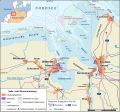User:ScotXW


Einige Leute habens sich beschwert, dass meine Schemata zu "kompliziert" seien (wohl weil sie Dinge im Zusammenhang darstellen) und ich sie massiv in der Wikipedia verlinken würde... hmmm. Zu zweiten Punkt schreib ich mal nix..., zum ersten Punkt aber: in der Tat könnte man meine umfassenderen Schemetas verwenden um mitunter stark vereinfachte Schemata zu erstellen, um damit Sachverhalte zu verbildlichen um sie besser erklären zu können. Die Wikipedia will ja (angeblich) Dinge erklären. Das Problem ist, dass diese vielen einzelnen Schemata dann gar nicht mehr, insbesondere nicht über mehrere Sprachen hinweg, pflegbar wären. Schon jetzt gibt sich kaum ein Schwein die Mühe, Schemas überhaupt zu erstellen, geschweige denn, diese mehrsprachig zu gestalten und sie zu pflegen. Pflegen heißt, sie möglichst auf dem neuesten Stand zu halten, Fehler auszumerzen, die Farbgestaltung zu verschlimmbessern, etc.
Die Lizenz erlaubt es jedermann, vereinfachte Derivate zu erstellen, die meinetwegen auch noch bestimmte Zeitpunkte/Versionen wiedergeben. Meiner Meinung nach, sollte man damit jedoch nicht die Wikipedia fluten, sondern diese in z.B. Linux-Wikis verwenden, die eben, die Funktion einer ganz bestimmte Version haben wollen und gerade nicht das Neuste.
Und noch einige unhöfliche Weisheiten um unfruchtbaren Diskussion entgehen zu wirken:
- Jedem das seine.
- Der beste Weg, jemanden von der Dummheit seiner Unternehmung zu überzeugen besteht darin, sie ihn ausführen zu lassen… Was wenn jemand so dermaßen dämlich ist, dass er/sie/es es immer noch nocht sieht???
- Wenn der Klügere immer nachgibt, regieren am Ende Idioten die Welt.
- Fresst Scheiße, tausend Fliegen können nicht irren.
Templates[edit]
- {{Retouched picture}} {{Translate}} or {{Convert to international}} {{Attrib}} {{Valid SVG}}/{{Invalid SVG}} {{Convert to SVG}} {{Vector version available}}
- Multiple translations within one SVG file
- {{Move}}, {{delete|miserably quality, svg available|day=29|month=July|year=2016}}
Linux[edit]
There is no one Linux operating system, but there is an entire family of Linux kernel-based operating systems. While a Linux kernel-based operating system targeted at desktop computers may have many software components in common with one targeted at tablet computers, the only components they share with one targeted at embedded systems, may be merely the Linux kernel itself.
The family of Linux kernel-based operating systems[edit]
-
Linux kernel interfaces: Linux API and Linux ABI
-
System Call Interface and glibc (No system without a standard C library)
-
The Linux API: System Call Interface, glibc, libcgroups, libalsa, libdrm and libevdev
-
very simply put
-
according to Andrew Stuart Tanenbaum
-
Playing a game on Linux, OpenGL, Mesa 3D
-
systemd for environment-level virtualization: containers
-
How does the "Linux desktop" work?
Linux adoption[edit]
-
Linux kernel ubiquity.svg Linux kernel is cool, but we require a complete OS to get our s*** done.
-
Linux kernel API.svg Distinct support for Linux through the Linux kernel API, and the rest through Single UNIX Specification/POSIX;
-
LAMP software bundle.svg LAMP; without the need of a graphical user interface, Linux has long ago achieved market shares of 60% and more. So what ails the "Linux desktop"?
-
Linux kernel and gaming input-output latency.svg Linux as a gaming platform: addressing latency concerns
Linux for embedded[edit]
-
Oxygen devices.svg Examples of devices that use embedded systems
But let's have a look at OpenWrt. It runs on embedded devices with 32MiB of main memory and consists of: Linux kernel, uClibc, BusyBox, dnsmasq and some other software with small footprint. It does routing and packet filtering, though on the Ben NanoNote does include a graphical surface (Xfce I think)!
Linux with a graphical surface[edit]
The "graphical surface" is usually called "desktop environment" even if it runs on a tablet computer or a smartphone.
So there are some daemons running, there are several competing widget toolkits to write graphical surfaces for them daemons and also for applications.
Graphical surface? Uh, we require a windowing system and maybe device drivers for graphics and video accelerators... for Smartphones, Google developed Android OS, which has a market share of 86%. For the traditional desktop computer, there are GNOME, KDE SC, LXDE, Xfce, Razot-qt, Hawaii, etc. and the market share is claimed to be 1%...
The Linux graphic stack[edit]
- How does the graphic stack of a Linux OS look like today? How did we get here? Why did it take so long?
History[edit]
-
2D drivers inside of the X server
-
Finally all access goes through the DRM
-
In Linux kernel 3.12 render nodes were merged, DRM and KMS driver were split. Wayland implements direct rendering over GBM/EGL
-
Proprietary and free drivers, X display server and Wayland compositor
-
Illustrates the idea behind Gallium3D
-
Gallium3D remove code duplication, but also costs some performance!
Clearly, the adoption of X as the window system was one mistake and the integration of the device driver for graphics accelerators into the X display server was another mistake. Since early 2000 DRI is augmenting and replacing the DDX and since late 2013 Wayland is replacing X. AMD and Nvidia develop proprietary device driver for their graphics cards for the Linux kernel which deliver comparable performance to the Windows drivers. See e.g. http://www.phoronix.com/scan.php?page=article&item=gpus_windows81_ubuntu&num=1 Inside of Mesa 3D, alternative free and open-source device drivers are being developed by independent programers for different reasons.
Windowing system[edit]
What actually is a windowing system? X11 is in the process of being obsoleted by Wayland. This solves a couple of problems annoying the end-user, but a whole lot of problems annoying software developers and system administrators!
Other components[edit]
- So, what are typical components of a Linux OS?
- Does the average user need to know about them or even need to make use of them?
Screenshots[edit]
Hardware[edit]
[edit]
Maps[edit]
Missing mapping for e.g.
- nl:Europoort / nl:Haven van Rotterdam
- en:Port of Shanghai / en:Yangshan Port
- en:Port of Singapore
- de:Tanger-Med
- …
Biggest problem with OpenStreetMap is the localization of the names. I cannot read chinese characters…
Issues[edit]
en:GNU GRUB supports GUID Partition Table (GPT) but File:GNU GRUB components.svg does not illustrate this. The en:dm-crypt use case is identical to the non-encrypted version, since encryption support is AFAIK in the Linux kernel only. Could be interesting to depict this, to make it clear, that the Kernel is exposed, hence dm-crypt is only really useful for mobile devices, that can get stolen. Well, would be nice to illustrate why.


































































